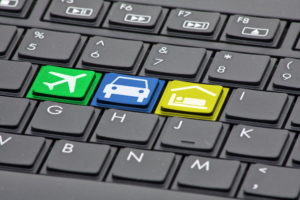In terms of sustainable business travel the COVID-19 pandemic has shown us that a central element in the modern business world can be the use of modern communication technologies. However, Zoom, Teams, and similar platforms do not provide a long-term replacement for in-person meetings. Especially with the end of the pandemic, meetings are increasingly being held in person again. Clients, customers, and partners value direct interaction face-to-face, rather than being separated by a screen.
Table of Contents
Top of the agenda: Sustainability and travel safety
Now that business travel is back again, we should do everything we can to make it more efficient through careful planning and optimization. Reducing CO2 emissions plays a key role in this, e.g., by choosing flights with lower CO2 emissions, choosing environmentally friendly means of transportation such as trains or electric vehicles or staying in sustainable hotels.
Sustainability is no longer just a buzzword for companies. Numerous governments are also making commitments to reduce greenhouse gases. Consumers today are paying much more attention to their own ecological footprint and are aware of the problems of climate change.
According to a survey by the German Business Travel Association (VDR), the topics of sustainability and travel safety are at the top of the agenda, right behind process optimization. With its EU-wide Corporate Sustainability Reporting Directive (CSRD), the European Union will also clearly position itself in this area from this year and demand that companies act in an environmentally conscious manner.
Travel guidelines for employees – raising awareness for sustainable business travel
Companies can promote the awareness of environmentally friendly travel among employees through regular training and information campaigns, sharing best practices and highlighting success stories. Incentives and rewards can encourage sustainable behavior. For example, employees who plan their flights in a particularly CO2-efficient way could be rewarded with a bonus program, additional vacation days or public recognition within the company. This not only motivates employees, but also strengthens their commitment and loyalty to the company.
Planning sustainable: Provide the best possible support during the selection process
While avoiding the trip is the most radical option, the trend leads more towards sustainable planning. The German Business Travel Association has developed an 8-step model for sustainable planning and thus provides valuable input for climate friendly and sustainable business travel:
- find digital alternatives
- inform in advance about CO2 optimization in travel planning
- the CO2 emissions should be a decision criterion when booking
- make decisions during the trip that have a positive impact on the carbon footprint
- record receipts and collect CO2 data for later
- carry out a CO2 footprint calculation and use the result for offsetting
- align supplier selection with CO2 reduction
- control processes with regard to consistent CO2 reduction
At PASS, we have built up expertise in the field of data and information relating to CO2 emissions and sustainable business travel over the past few years. My colleague Silvia Bolte has also been contributing her expertise to the relevant VDR expert committee for some time now.
Software solutions for sustainable business travel
The business travel selection process can be greatly assisted by specialized software solutions to promote sustainability. Here are some ways in which such software can help:
Travel cost analysis and optimization: The software can analyze and optimize the costs and environmental impact of different travel options. For example, it can give preference to rail travel over flights or suggest the most efficient routes that minimize CO2 emissions.
Highlight environmentally friendly options: When booking flights, hotels or rental cars, the software can highlight and give preference to environmentally friendly options. This includes, for example, the selection of hotels with environmental certificates or rental cars with low fuel consumption or flights with using sustainable aviation fuels (SAF) and offset of CO2 emissions like the Lufthansa Green Fares.
CO2 calculations and offsetting: The software can automatically calculate the carbon footprint of each trip and offer suggestions for offsetting measures. This could include the direct integration of CO2 compensation projects into the booking process.
Policy integration and compliance: Companies can integrate their sustainable travel policies into the software so that employees are automatically reminded of these policies when booking and are guided to choose options that comply with company guidelines.
Travel approvals and reporting: The software can implement approval processes for trips where sustainable alternatives are reviewed and prioritized. It can also generate detailed reports on the environmental impact of all business trips to facilitate the monitoring and improvement of sustainability strategies.
Training and awareness raising: The software can also provide information modules and training materials to educate employees on the importance and methods of sustainable travel.
Make it sustainable: Mapping of the entire travel process
Sustainable door-to-door routing and comprehensive planning of the entire travel process can make a significant contribution to promoting sustainable business travel. By integrating all travel segments and means of transport into a unified planning, this concept enables a detailed analysis and optimization of the entire trip. By selecting the most efficient and environmentally friendly routes and transportation options, CO2 emissions can be significantly reduced. The remarkable switch from taxis to public transport was stated as one of the most surprising results at the presentation of the VDR business travel analysis.
In addition, continuous monitoring and adjustment helps to avoid unnecessarily long routes, inefficient itineraries and hotels with a poor carbon footprint (e.g., caused by the use of plastic tableware, plastic waste and the high consumption of towels and other accessories) minimizing both the environmental footprint and travel costs.
By using these technologies, companies can not only better implement sustainable travel policies, but also improve the travel experience for their employees by providing seamless and efficient door-to-door navigation. This leads to higher traveler satisfaction while contributing to the company’s sustainability goals.
Until the industry manages to optimize air travel through new propulsion systems or sustainable aviation fuel (SAF), the focus for business travel should be on finding ways to accurately measure business travel emissions. With this data, planners can make informed decisions to plan sustainable and responsible business travel and simultaneously get a good base for the requested/obligatory business reporting.
PASS SolutionWorld Travel ... and CO2-Data
Header: Shutterstock




